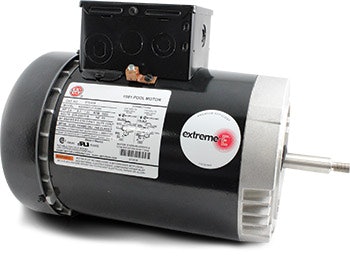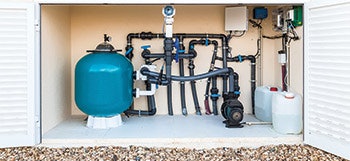Like any piece of machinery, the day a pool pump motor is put into service is the day it begins to deteriorate. For the bearings, the windings, the insulation and the casing, the countdown has begun until one of these crucial pieces fail and the pump can turn no more.
Pump motor failure and replacement rates have been an issue in the pool and spa industry for decades, but as the industry matures, the drive is toward extending life and thus necessitating fewer customer calls to the service professional.
Corrosion and water intrusion is just one pump failure mode, but it's a crucial one, particularly when the pump works outside in the elements or near the briny sea, where the salty air results in an oxidation process we call "rust."
Areas and applications like that can see improved failure rates with the use of a pump that does not allow ambient air or water inside the motor casing. What sort of pump is that? One with a totally enclosed, fan-cooled motor. Or a TEFC, for short.
Drip Proof?
 A TEFC motor from U.S. Motors. TEFCs bring greater isolation from ambient conditions than drip- proof pool motors.
A TEFC motor from U.S. Motors. TEFCs bring greater isolation from ambient conditions than drip- proof pool motors.
Most pump motors sold in the pool and spa industry are called "open, drip proof" or ODP motors.
This name comes from the fact that the motor housing is not sealed, but still encased fairly well except at the bottom where there are small holes, like weep holes in a window, where any trapped water or condensation can leak out.
Pump and motor manufacturers certify these ODP motors to a standard called UL 1081. Jim Ellis, industry veteran and senior market development manager for pump applications at Nidec describes the process:
"To pass the test, they run the motor for four hours with three misting jets squirting water on the motor. Then they apply high voltage for about a half-second to see if the insulation has broken down, and they check to see if there is any water on the electrical components. If you pass these tests you are UL-1081 certified from a water protection standpoint."
That has been the baseline water protection standard for some time. But of course, as we all know, many real pumps in the field are likely to encounter something worse than four hours in a misty rain. In an outdoor application in Seattle, they'll see that in a single day.
"Over time, rain and the outside elements can really go to work on your pump," says Mike Fowler, commercial marketing and sales manager for Pentair Aquatic Systems in Sanford, N.C. "Even if the pump is inside, it may be in an environment with chemical fumes, or just moisture, and those things can get into the inner workings of a motor — the windings, the bearings — and attack them."
 Swimming pool equipment room near the Florida coast. Even ODP pumps installed inside a protective shelter can be vulnerable to corrosion caused by salt air.
Swimming pool equipment room near the Florida coast. Even ODP pumps installed inside a protective shelter can be vulnerable to corrosion caused by salt air.
Coastal areas present a particular problem to an ODP motor, adds Ellis. "If you're running a pump down in Miami Beach and it's about 80 percent humidity and there's a lot of salt in the air — well, the motor is always sucking that air in and exhausting it out, so you're pulling in that saltwater air and sending it right down the center of the motor."
Needless to say, salt water is very corrosive to metal parts so as this process continues, day after day, the countdown to motor failure begins to accelerate.
"I would venture to guess there are some hotels along that coast from Florida up to Myrtle Beach that have not paid for a new pool pump in 25 years, because the typical warranty on a pool pump from a reputable manufacturer is three to five years, which is fine in other parts of the country, but in that climate they're just not going to make that three to five years. The hotel turns it in for warranty, and somebody comes out and replaces it," Ellis says.
The Raincoat vs. The Umbrella
Because of this vulnerability to certain ambient conditions, some time ago engineers at pump manufacturing companies came up with the TEFC. In a TEFC, the motor housing is sealed and a fan blows across the outside of the casing, dissipating heat through fins in a scheme similar to other types of air-cooled motors.
By sealing the housing, motor components stay dry. "Think of the difference between an ODP motor and a TEFC motor as the difference between an umbrella and a raincoat," Ellis says. "That ODP motor — that umbrella — will keep you dry up to a point and it is a fine option, but the TEFC motor is more like a raincoat, which will keep you dry indefinitely."
Of course, a raincoat costs more than an umbrella, and likewise, the price difference between the motors has hindered the acceptance of TEFCs in the pool and spa industry, where many customers steer hard for the lowest cost, Ellis says.
"I see the industry today as kind of Walmart-ized in a way," he says. "We often tend to just buy the cheapest available product without thinking about the long-term ownership costs, and that's often true of pumps and motors.
"Don't get me wrong, the ODP products work," he adds, "But for the OEMs and the customers who really need something dependable that will make it to the warranty expiration date in areas where corrosion is a real problem, TEFCs are the way to go."
Commercial and ResidentialOn the commercial side of the business, TEFCs have enjoyed wider acceptance than the residential side, for reasons that reflect commercial priorities. "Some of the larger design firms have been spec-ing TEFCs for some time now," Fowler says, "because they're looking for a safer way to go. They're looking for longer life and less risk of damage because it's protected." At the same time, market penetration on the residential side has been greatest in the variable speed segment. If a variable speed pump is sold on a residential application nowadays, most likely the motor is a TEFC. The relatively high cost of a VS pump is just too much money for a homeowner to risk on a pump that may fail before the warranty runs out. "The variable speed products, the variable flow pumps, those are all TEFCs because when you put the variable speed drive on it, the drive is easily double the cost of the motor," Ellis says. "So if Joe homeowner, who used to go out and spend $150 on a replacement pump is suddenly told he needs to spend $850 for a variable speed pump — well, it better last for a while or he won't be very happy." |
Comments or thoughts on this article? Please e-mail [email protected].








































